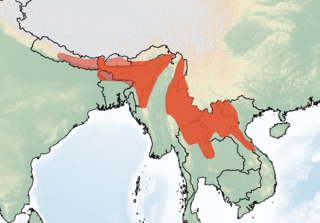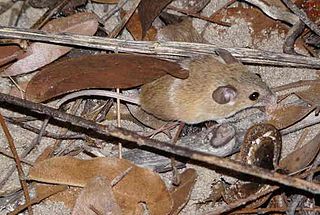
Apodemus is a genus of Muridae. The name is unrelated to that of the Mus genus, instead being derived from the Greek ἀπό-δημος.

The genus Mus or typical mice refers to a specific genus of muroid rodents, all typically called mice. They are the only members of the tribe Murini. However, the term mouse can also be applied to species outside of this genus.
The Ethiopian striped mouse or striped-back mouse is a species of rodent in the family Muridae. It is only found in Ethiopia. It was formerly classified in the monotypic genus Muriculus, but phylogenetic evidence supports Muriculus being a subgenus within Mus, the true mice. The Ethiopian striped mouse's natural habitats are subtropical or tropical high-altitude grassland and urban areas. It is threatened by habitat loss.
The toad mouse is a species of rodent in the family Muridae. It is found in Burundi, Democratic Republic of the Congo, Rwanda, and Uganda. Its natural habitats are subtropical or tropical moist montane forests and arable land.

The Ryukyu mouse is a species of rodent in the family Muridae. It is found in Cambodia, China, Indonesia, Japan, Laos, Malaysia, Taiwan, Thailand, and Vietnam.

Cook's mouse is a species of rodent in the family Muridae. It is found in southern and south-eastern Asia from India to Vietnam.
The Gounda mouse is a species of rodent in the family Muridae. It is found only in Central African Republic, around the Gounda River. Its natural habitat is moist savanna.

The desert pygmy mouse is a species of rodent in the family Muridae. It is found in Angola, Botswana, Namibia, South Africa, Zambia, and Zimbabwe. Its natural habitats are dry savanna and subtropical or tropical high-altitude grassland.
The Free State pygmy mouse or Orange mouse is a species of rodent in the family Muridae. It is found in Lesotho and South Africa. Its natural habitats are subtropical or tropical high-altitude grassland, arable land, and pastureland.
The Oubangui mouse is a species of rodent in the family Muridae. It is found only in the Central African Republic. Its natural habitat is dry savanna.
Phillips's mouse is a species of rodent in the family Muridae. It is found only in India. Its natural habitats are subtropical or tropical dry forests, subtropical or tropical dry lowland grassland, and hot deserts. It is threatened by habitat loss.
The rock-loving mouse, also known as the brown spiny mouse, is a species of rodent in the family Muridae. It is found in India, Nepal, and Pakistan.
Setzer's pygmy mouse is a species of rodent in the family Muridae. It is found in Botswana, Namibia, and Zambia. Its natural habitats are dry savanna, rivers, freshwater lakes, and intermittent freshwater lakes.

Shortridge's mouse is a species of rodent in the family Muridae. It is found in Cambodia, Laos, Myanmar, Thailand, and Vietnam.

The steppe mouse or mound-building mouse is a species of rodent in the family Muridae. It is found in grassland and other open areas in Austria, Bosnia and Herzegovina, Bulgaria, Croatia, Czech Republic, Hungary, North Macedonia, Romania, Serbia and Montenegro, Slovakia, Slovenia, and Ukraine.
The delicate mouse is a species of rodent in the family Muridae. It is found in Ethiopia, Kenya, Somalia, Sudan, Tanzania, and possibly Eritrea. Its natural habitat is dry savanna.
The earth-colored mouse is a species of rodent in the family Muridae. It is found in India, possibly Indonesia, Nepal, and Pakistan. The earth-colored mouse lives in cultivated fields in raised moist mounds of Earth, where they burrow and locate their nest about 20 cm or 8 inches deep. Living in a raised mound of soil offers them more oxygen flow from air coming through the surrounding sides as well as from above. In contrast, their co-existing sibling species Mus booduga burrow in the flat parts of the field, which allows for niche differentiation.
The gray-bellied pygmy mouse is a species of rodent in the family Muridae. It is found in Angola, Burundi, Democratic Republic of the Congo, Kenya, Malawi, Mozambique, Rwanda, Tanzania, Uganda, and Zambia. Its natural habitats are subtropical or tropical moist montane forests, subtropical or tropical seasonally wet or flooded lowland grassland, subtropical or tropical high-altitude grassland, and arable land.
The Pichincha Oldfield mouse is a species of rodent in the family Cricetidae. It is present in the Cordillera Occidental of the Andes of Ecuador, where its habitats include shrubby páramo and montane forest. It is nocturnal and terrestrial. The specific and common names are references to the volcano Pichincha, which dominates the city of Quito and on whose slopes the species was discovered at an elevation of 3500 m. The mouse is threatened by conversion of its limited habitat to agricultural use. It has sometimes been considered to be conspecific with Aepeomys lugens.

Coelomys is a subgenus of the rodent genus Mus, the mice. This subgenus is native to Southeast Asia.








